History of Little Bardfield Village
Location
OS Map 195. Grid Ref: TL 6595 3083 Lat: 51.9513 Long: 0.41350272 Height:77.5m
A minor road, the Bardfield Road, runs west to east through the village becoming Bell Lane towards Great Bardfield.
It is a dispersed settlement. Most buildings are detached, and most are of unique design with no consistent building style of any period.
Listed buildings: One Grade 1, Eighteen Grade 2.
Little Bardfield OS Map
Little Bardfield Centre
Census
As the Census of 2011 only covers the Parish as a whole, a separate headcount for the village is not available.
However, the number of persons qualified to vote in the last election was 139 residents of 66 houses.
Buildings of Interest
St. Katharine’s Church - Grade 1 Listed February 1967
The Church features extensively in the Parish History.
Grade 2 Listed 1985: Crinkle Crankle Wall to northwest of the Churchyard , part of the boundary wall to Little Bardfield Hall Monument attached to the east of the east wall of the Chancel.
Grade 2 Listed Houses, post codes and listing dates
Almshouses and School Attached CM7 4TR 1967
Appletrees CM7 4TR 1979
Chequers CM7 4TW 1952
Copford Hall CM7 4TL 1985
Furthermoor Hall
Gridiron Hall (Gridiron Cottage?) CM7 4TW 1985
Letches Farm
Little Bardfield Hall CM7 4TT 1952
Manor Cottage CM7 4TU 1977
Markswood Farmhouse CM7 4TY 1985
Moor Hall CM7 4SQ 1985
Hole Farm
Paul's Farmhouse CM7 4TN 1985
Pauls Cottages & The Mill
The Hydes C16 CM6 3QB 1985
Little Hyde
The Old Rectory CM7 4TW 1985
Barn Approximately 30 Metres West of the Old Rectory. Grade 2 Listed 1985
Stables Approximately 30 Metres West of the Old Rectory. Grade 2 Listed 1985
Three Chimneys (previously Three Cottages) CM7 4TS 1985
Wainsford Farmhouse CM7 4TW 1952
Other Houses of Interest
Fallow End
Guivers
Spread Eagle Pub / Eagle House
Squirells
Yew Tree Cottage
Almshouses and School Attached
These are covered extensively in the Parish History and in the Organisations sections.
1920

2006
Appletrees
Grade 2 Listed October 1979. C18, possibly Stuart, with later alterations and C19 left extension. There are references to this house being named “The Vatican” in 1920’s. Unsure if this was a local name or its registered name.

1920's

2006
Chequers
Grade 2 Listed February 1952. Situated about ¾ mile/1km east of the Church. In the 1920’s it was a Public House.

1900?

2006
|
1609 |
The house, nearly ¾ mile E.S.E. of the Church, was built probably in 1609 but has a modern addition at the back. In the middle of the east front is a small porch and staircase wing of which the upper storey and gable project in front. Carved in the bressemer of the gable is "P L Anno Dom 1609". In the plaster is inscribed "H S 1785" doubtless the date of the plaster work. The main doorway has a moulded oak frame and the door has ornamental strap-hinges, all probably of the 15th century re-set. The south gable has old barge boards carved with a zig-zag ornament. Inside the building, in the modern addition is a moulded battened door of the 17th century re-hung. |
|
|
17th & 18th Century: Not much is known about 17th and 18th century Chequers except that it was owned by the Bowyer family and it was a beer shop. |
|
1807 |
Humphrey Smith owned the house and land. |
|
1848 |
Charles Wood |
|
1894 |
George Emmens |
|
1911 |
Dr. Dawson owned the house. Mr. Redvers Burgess tells a nice little anecdote about him. “Dr. Dawson was a journalist and he gave a prize of five shillings for the best essay written by the schoolchildren on the subject 'The British Empire', to celebrate the Coronation of George V. The prize was won by G. Henry and R. Burgess. Mr. Burgess remembers being excited about winning but he couldn't remember whether the prize was a crown. All he remembers is spending it!” |
|
1920 |
The Misses Creed left the Hall and went to live at Chequers. About this time it was known to be a pub |
Copford Hall
Grade 2 Listed July 1985. This is about one-mile E.N.E. of the Church. It is of an L-shaped plan with the wings extending towards the N.W. and N.E. The N.W. wing is of late 16th or early 17th century date and the N.E. wing of slightly later date. There are modern additions on the N.E. side of the N.W. wing and at the end of the N.E. wing. Inside the building a room in the N.E, wing is lined with early 17th century paneling, re-set.
|
1530 |
It was called Great Cop |
|
1551 |
Walk-about refers to it as Great Copford |
|
1553 |
William Copford married Agnes Golding |
|
1593 |
It is possible that the mill was on the same site in the Domesday Book. Johanna Wayte, daughter of John Finchingfield drowned in the water mill and was buried in Little Bardfield churchyard. The Chishulls and Barnards owned the land |
|
1782 |
John Harrison owned it |
|
1807 |
Robert Smith owned it and lived there farming 31 acres |
|
1867 |
John Gowlett |
|
1894 |
John Mizen |
|
1910 |
George Ridgewell and Lionel Lary |
|
1930-1950 |
It was owned by Ernest Crocknell. Then it was owned by Miss Adshead of Beslyns who let to Mr. Thorogood |
Opposite Copford Hall on the other side of the river in Great Bardfield is a farm called Littles. (Tony Hayward, lives here 2019)
In 1551 it was owned by the Bottolphe family and was called Herswells.
In 1733 it was known as Little Copford and was farmed by Henry Clapton.
Gridiron Hall
Now Gridiron Cottage. Grade 2 Listed July 1985. Marked on the 1876 Map.

2006
At one time this property belonged to the Moor Hall Estate and was called cottage and garden. In 1860 Thomas and Judith Andrews lived there. People still remember Mrs. Andrews who lived there in 1909. She baked bread and made sweets which the children bought for ½d a bag. The house was then two cottages. Her son was nicknamed "Uppie" and he had a reputation as a "wart charmer".
Furthermoor Hall
This is mentioned in the ancient history but has long since disappeared. It is recorded that Giles Chishull lived there.
Commercial buildings were erected about 2005 at location GR 647304 and resurrected the name Furthermoor Hall.
Letches Farm
This lay on the east side (river side) of the lane from Moor Hall towards Cooks Lane near the high point. It is marked on an 1876 map, but it no longer exists and there is no trace of it at that location. It was farmed originally by George Letch who died June 23rd, 1782. Their water supply at that time was from a well opposite the house. The farm is shown at the top of this ancient map. Of interest is the field on the left of the map which states that this field was in Great Bardfield Parish but in 1883 it was "amalgamated with Little Bardfield Parish".

Many of the Letch family are to be found in the Parish Registers. The farm was possibly situated where the gap is in the hedges on the east side of the lane which is used as a passing point. There is a water supply stop cock at the north edge of this gap which suggests the presence of a property there at some time.
Little Bardfield Hall
Grade 2 Listed March 1952. It is situated to the west side of the Church. GR 655306.
Ancient History
The Manor House, Fitzwrafe Manor, is mentioned extensively in the Parish History. Roman fisheries existed to the west of the Hall at GR 650306. The entry in the Domesday Book of 1086 shows the Earl of Boulogne living in the original Little Bardfield Hall when it was a Manor House. In 1351 it was given to St. John’s Abbey Colchester. In the late 16th Century it was re-built from a Manor House into a Hall. In 1790 it was occupied by a Jacob Mountain (1749-1825), a bishop and politician and his wife Elizabeth Mildred Wales, co-heiress of Little Bardfield Hall. In 1816 Luke William Walford, High Sheriff of Essex lived in Little Bardfield Hall when it was still a Manor House.
It was later changed to represent a 15th Century, possibly Tudor, Manor House nestled in a sixteen-acre parkland setting.
What follows here is it's more recent History illustrated by many photos.

1907

1920

2000 This appearance probably more closely resembles the original structure.
The Lodge

1900's
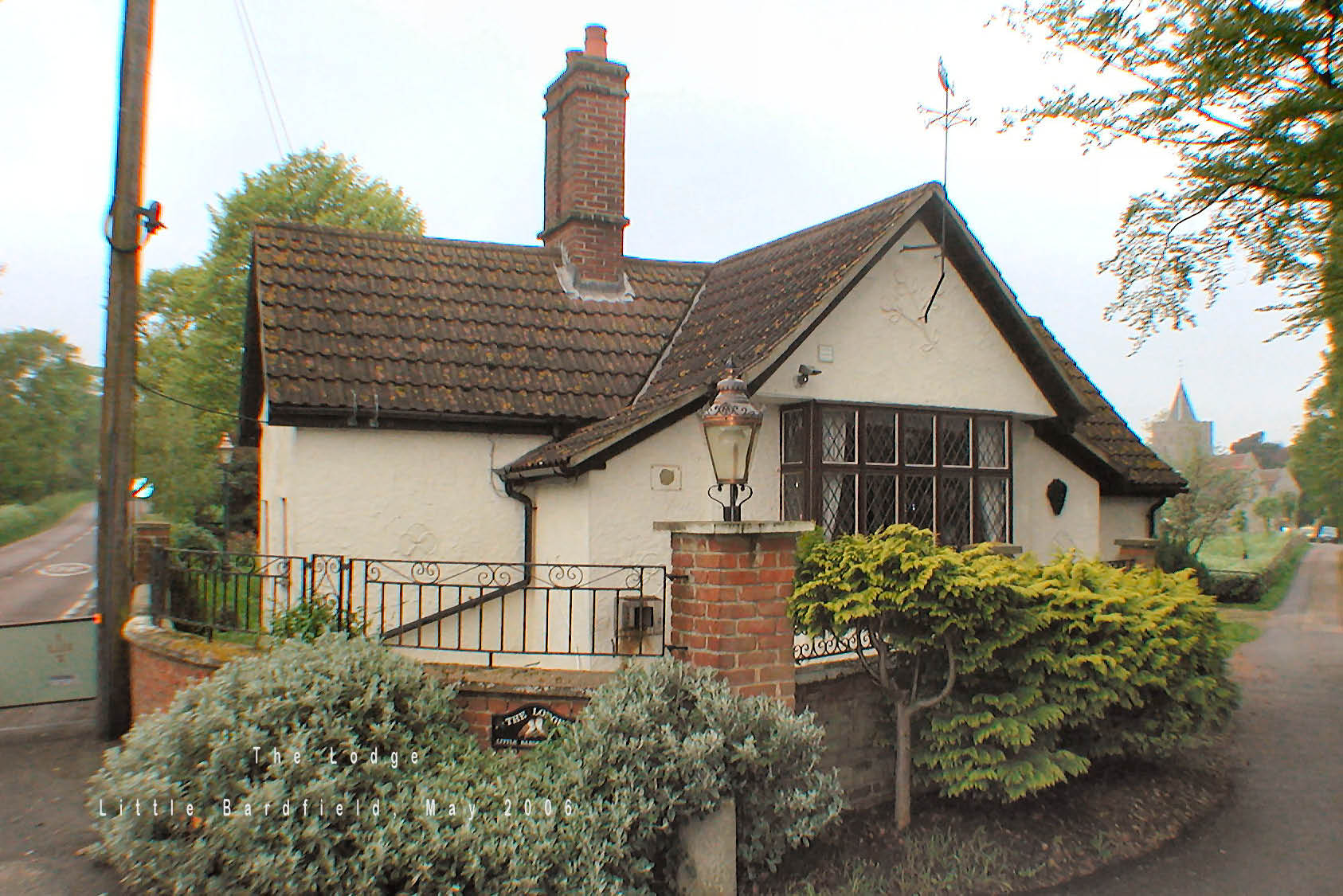
2006
A 1876 Map shows the entrance drive to be from the Lodge, lined with ancient elm trees. This is now the pathway to the Church whilst the entrance drive to the Hall entrance is to the west of the Lodge, directly in front of the Hall.A 1876 Map shows the entrance drive to be from the Lodge, lined with ancient elm trees. This is now the pathway to the Church whilst the entrance drive to the Hall entrance is to the west of the Lodge, directly in front of the Hall.

1900's
History since 1900
|
1900 |
Mr. Richard Creed owned the Hall. He was an architect and there are still people living (written 1979) who can remember him travelling across the bridle way to Oxen End with his chaise and two horses on his way to Dunmow and then to London. He died 1914. His widow continued to live at the Hall with her daughters. |
|
1919 |
Mr Creed’s daughters went to live at Chequers. |
|
1922 |
Mr. Sidney Letts, a Circus owner, came to the Hall and he altered the Georgian façade which the Wales had added giving it the mock Tudor frontage. He died 1940. |
|
For a time, the Hall was empty. |
|
|
1942-1945 |
The Hall became a Barnardos mixed home for children evacuated from the city. |
|
1949 |
Squadron Leader Dyer bought the Hall and ran it as a country club until his death in 1976 The barn was famous as a Blues Club. Local stories tell of it operating in the 1950’s/60’s as a nightclub frequented by American air force personnel who were then based at RAF Wethersfield where they operated jet fighters including F-84G Thunderjets and F86 Sabres. |
|
1977 |
Mr Sagger bought the Hall and carried out many unauthorised internal alterations of an Indian style. |
|
1980’s |
A Planning Application was raised to turn the Hall into 144 room hotel and golf course. Fortunately, this never happened otherwise the medieval habitat would have been destroyed for ever. |
|
1993 |
Mr Alan and Mrs Kathy Goldsmith bought the Hall and spent two years restoring it to its original beauty before taking up residence in April 1995. It is mention in Marcus Binney’s book “In Search of the Perfect House”. The grounds include a Mediaeval wild flower meadow, beautiful orchards filled with wildlife and four spring-fed lakes that were man-made by Norman monks. Both the grounds and Little Bardfield Hall itself have been used for film and television location work. |
Little Bardfield Hall Country Club & Barn Night Club
It is uncertain which of the two venues were used for what entertainment. Apparently, the infamous Krays Brothers were known to have been frequent visitors.
The barn was situated to the east of the Hall on a site which is now occupied by three luxury houses on St Katharine’s Green.
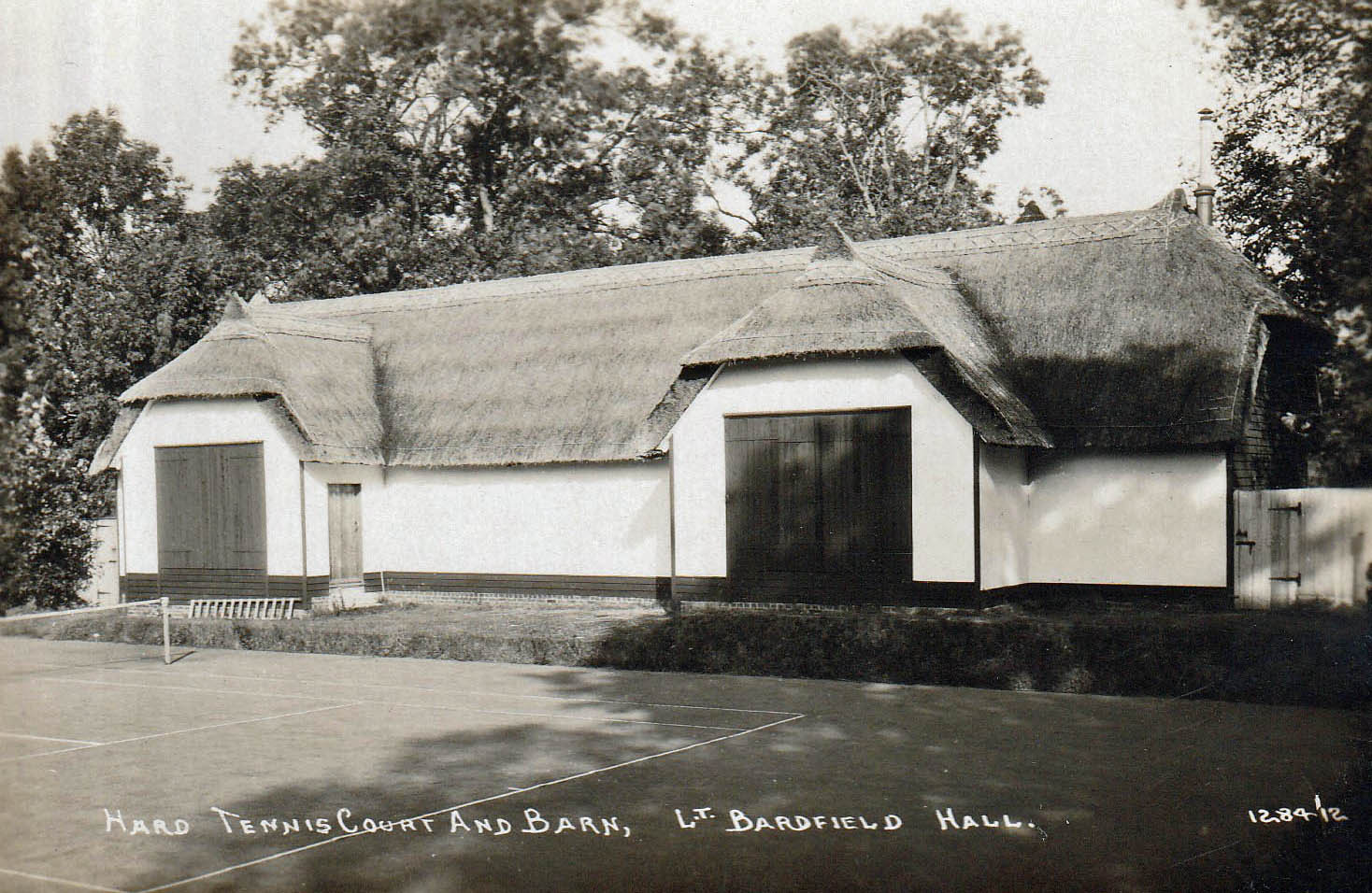
1920's
Some of the bands and acts appearing in the 1960’s were:
Dusty Springfield & The Springfields
Art Wood (older brother of Ronnie Wood of the Stones).
Alex Corner
Cyril Davis All Stars
Shane Fenton / Alvin Stardust
Ricky Valence
1969, July 26, Ian Gillan & Roger Glover of rock band Deep Purple Episode Six played their last gig in Little Bardfield Hall.
1970, April 18, Mott the Hoople; April 24 Trader Horne
The Barn Club is the top entry in this advertisement for June 6th published in the Melody Maker Newspaper. Research on the bands around at that time indicates possibly 1966 as the year.

2006 August Summer Concerts in the Hall grounds.

Bands and acts that appeared included:
Glenn Miller Sounds of Swing Orchestra
Kenny Ball & his Jazzmen
Eric Delaney Band
Rosemary Squires
Regrettably, one local resident complained to Uttlesford District Council who invoked many unreasonable constraints so further concerts became impracticable.
Manor Cottage
Grade 2 Listed 1977. Probably C17, possibly Stuart.

1920's Note the car - Austin 7?

2006
Although there has been a major extension, the roof line, windows and chimney identify this as the same 1920’s house.
Harold Joseph Laski (1893-1950), Labour Party Chairman 1945/46 bought Manor Cottage in 1935. History records that, after the 1945 landslide election, his opinions clashed with those of his Prime Minister Clement Attlee and Foreign Secretary Ernest Bevin. He soon lost his position. His emphasis was on Marxism, class conflict and workers revolution. He was a friend of American TV & radio journalist Ed Murrow, Head of CBS News in Britain, who visited the village with a radio crew in tow to go drinking in the Spread-Eagle Pub. They recorded and subsequently broadcast to an international audience a programme of songs sung by “a local poet from a village pub in Essex”! Laski died of flu in March 1950 at the age of 56, by which time he had sold his cottage and moved to London.
Markswood Farmhouse
Grade 2 Listed July 1985. It is situated on the lane which leads south from the Furthermoor Hall buildings to wards The Hydes Solar Farm.
Markswood belonged to the Bottolphe, Wale, Owen families and was called the Lodge. In 1671 it had 100 acres of land. In 1807 it was still called the Lodge. John Phillips farming the land and living in the house. He died in 1837 aged 70. Luke Walford owned the land in 1838. In 1848 William Phillips lived at the Lodge and also farmed Hall Farm. A John Phillips who lived at the Lodge is recorded as having done a survey for a farm in Mauden in 1841 so perhaps he was a surveyor as well. The original wood measured 130 acres and stretched right across the present-day road.
Moor Hall and Hole Farm
Moor Hall, Grade 2 Listed July 1985, on Hawkspur Green Road (renamed by UDC as Little Sampford Road). Built C17 or earlier. Possibly Stuart. Late C19 addition to the right. An active farm and residential accommodation.
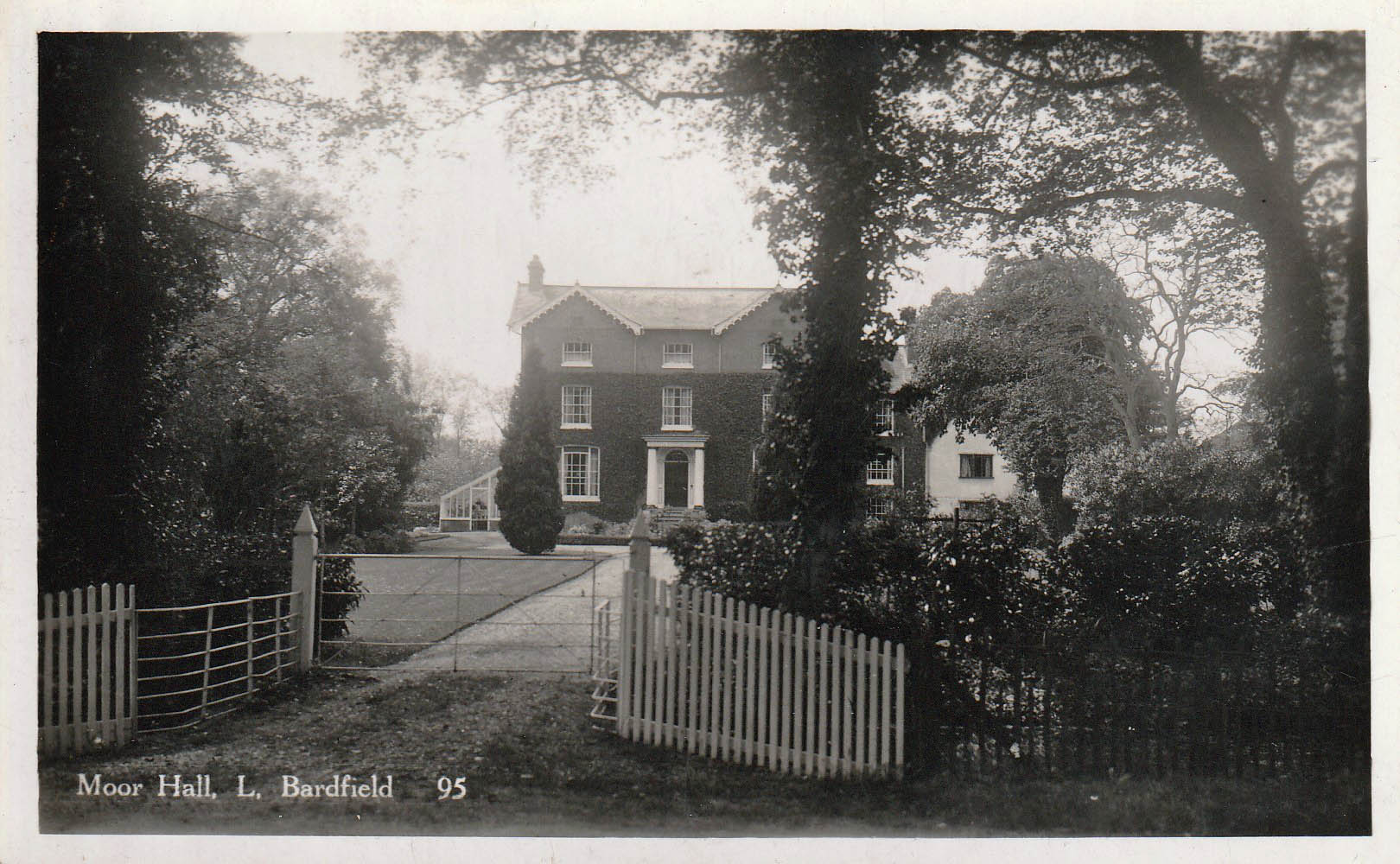
1920's
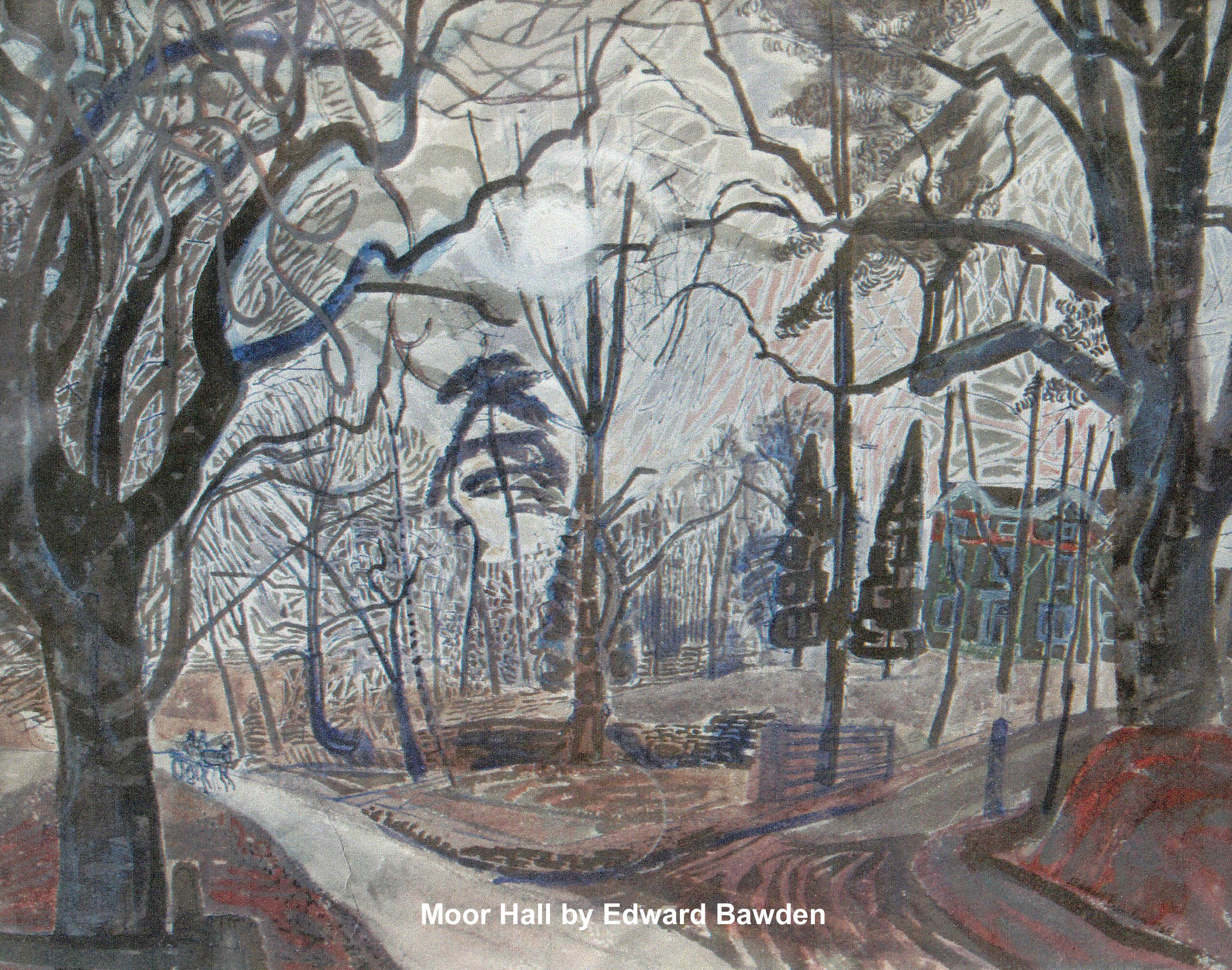
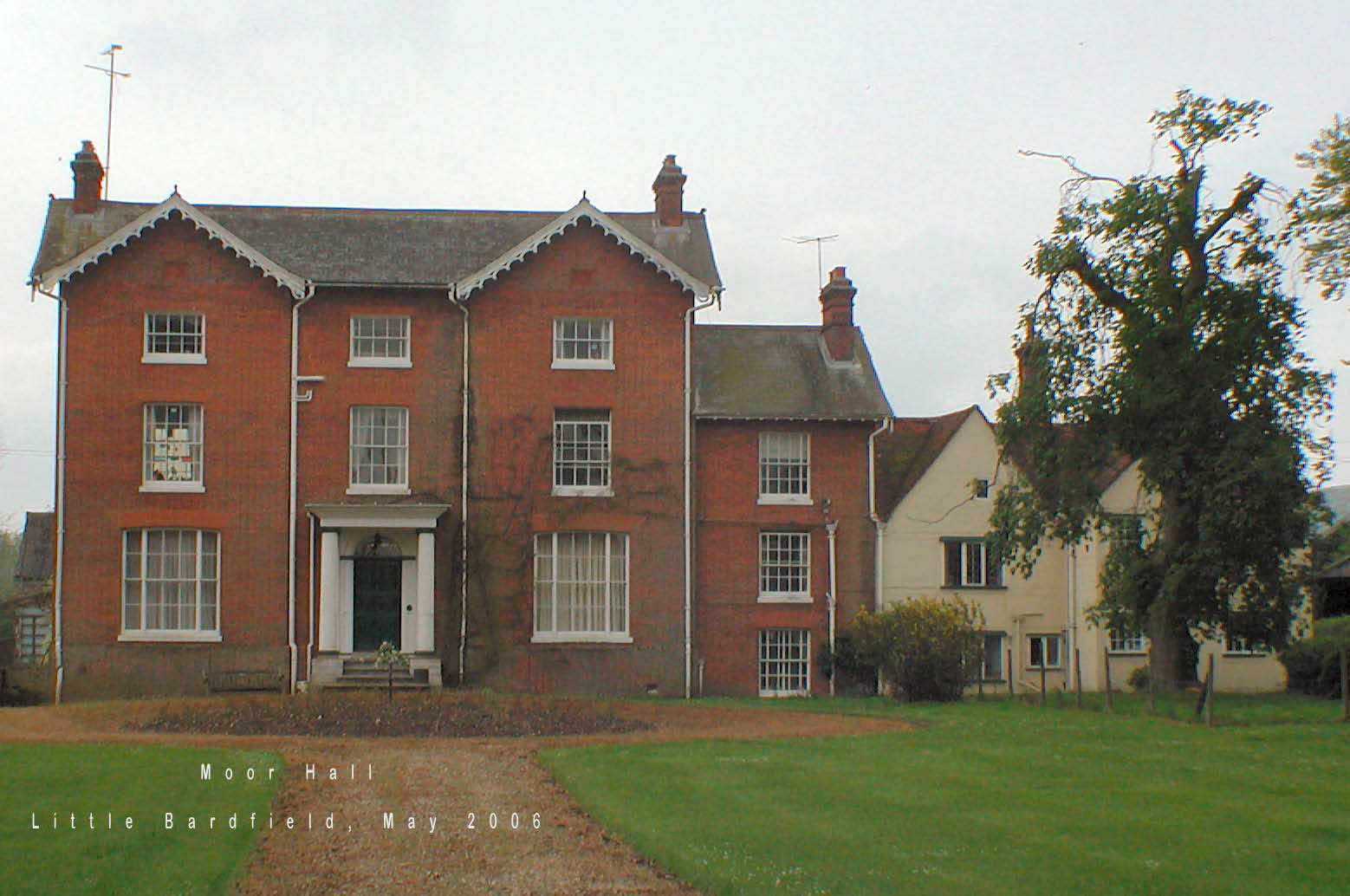
2006
|
1712 |
It was known as Unwins as the tenant farmer was a John Unwin |
|
Hole Farm |
On the 1777 map Hole Farm lay to the north of the present Moor Hall. To north of Moor Hall, on the road to Hawkspur Green, is a drive between a line of trees. This was the chase up to Hole Farm. Hole Farm was also called Winterfloods. To add to the confusion, the same family also farmed Gambers. |
|
1777 |
Moor Hall was also spelt as More Hall on some documents. A small cottage stood on the present site of Moor Hall and today (2019) there is still a very old cottage joined to the side of Moor Hall. A well used to be marked on the ordnance survey map behind the present Moor Hall but no longer appears. |
|
1807 |
Robert Smith owned Hole Farm land but by 1838 the farm house had disappeared, and the land had been absorbed and was being farmed by Hezekiah Smith who had some 84 acres, 54 of them in Little Bardfield. |
|
1810 |
Humphrey Smith farmed the land and by 1838 Robert and Hezekiah Smith farmed 67 acres |
|
1838 |
Moor Hall was occupied at this time by William and Sarah Bernard. Hezekiah Smith lived at Beslyns. |
|
1867 |
Henry Rawlinson lived at Moor Hall |
|
1870 |
A Mr. Perkins "Occupier of Moor Hall, stated that his rents were too high". |
|
1878 |
Thomas Tilbrook |
|
1905 |
Francis Payne, his wife dying in 1906 |
|
1906 |
George Sadler bought the farm and let it to G.H. Bell during the first World War, returning to farm it himself in 1917. |
|
1922 |
George Sadler sold land at Furthermoor Hall to Mr High Craig Senior who also bought glebe land making a total of over 150 acres. It was Hugh Craig who donated the field for the Cricket Ground in the village. |
|
1925 |
Walter Hosgood owned More Hall |
|
1942 |
Bought by Mr Austin Gardiner who also bought land attached to Wainsfords in 1952. |
|
2020 |
Sold to new residents by Mr A W V Gardiner |
Paul’s Farmhouse
Grade 2 Listed July 1985. The farm house lies 5/8ths of a mile E.S.E. of the Church with a modern addition on the west side.
|
1553 |
This farm was originally called Pools and today is called Pauls. This land was owned by Mr. William Benlowes in the walkabout of 1551-1661. Whether this Mr. Benlowes was the Sergeant at Arms of Great Bardfield is difficult to discover. Only a few aces came within the boundaries of Little Bardfield and these were on the west side of Black Lane. |
|
1759 |
William Cracknell owned the farm and at that time he called it Cracknells. He died in 1759 |
|
1824 |
Owned by Humphrey Smith. The acreage was then 154 which included Wainsford and Chequers. Joseph Holland was the tenant. |
|
1848 |
Owned by John Taber and Richard Bedlow was the tenant |
|
1852-1896 |
Mr Richardson was the tenant. |
|
1894 |
Thomas Stock is recorded as having lived there in 1894 though whether as owner or tenant is not known. |
|
1900 |
Mr. Creed owned Pauls |
|
1911-1928 |
Mr. Henry Burgess and his family were living there. Mr. Reynolds was the tenant. |
|
1946 |
Mr. Foster owned it. |
|
1958 |
It became part of the Moor Hall Farms estate. |
|
2000’s |
Mr & Mrs Patrick Gardiner live there |
Pauls Cottages & The Mill
Pauls Cottages
1551: At one time it was called Pooles Farm and Mill and according to the 1551-1661 perambulation, this farm had 12 acres and a John Marion lived there.
1831: William Phillips lived there before moving to Markswood.
1838: the trustees of Humphrey Smith owned it and also the Mill. As Humphrey Smith also owned Cracknells the land must have been absorbed into that farm as the cottages today have no land with them.
The Mill
It stood on a mound between the Old Rectory and Copford Hall opposite Pauls Cottages, GR 667312. It is not certain when the Mill disappeared but probably in the middle of the 1800’s. The meadow on the right facing the house was common land and the field on the left between Mill House and the Rectory running down to the river, was glebe land.
1607: Thomas Parker owned the Mill and then nothing is known until 1814 when Thomas Bambridge, miller, worked it. He died in 1848 aged. 83.
1835: James Womwell was the Miller. He died 1856 aged 69 and both these Millers are buried in the Churchyard.
The continuation of Miller goes: James Milbank, Joseph Simmons, J.T. Simmons until 1905.
1905: G. Davey owned only the Mill. Then Moses Braid followed by his son George. George Broid's niece married B. Jefford and they lived at the Mill House for a time.
1960’s: George Davey left the house to Alice Letch who lived there until she sold it to Sir (Baron) Bernard James Miles CBE (1907-1991) the renowned Actor, Writer and Producer, who lived there and also founded the Mermaid Theatre in London on the north bank of the River Thames.
The Hydes
Grade 2 Listed July 1985. C16, Possibly Tudor. Located about a mile N.W. of the Church.

| The house was built in the middle of the 16th century on an L-shaped plan with the wings extending towards the east and south. | |
| 1551 | There was much land attached to the Hydes. While the house and a small amount of land stood within the boundaries of Little Bardfield the greater part lay in Great Bardfield and Thaxted. Giles Chishull owned the Hydes at this time although Christopher Pepper lived there. He was related to Charles Wale who farmed at Ashdon and is buried in Saffron Walden Church. |
| 1674 | The Hydes paid Hearth Tax on four chimneys. |
| 1682 | Joseph Hull lived there. In his will he left to his wife Sarah, his "bed, bedding, stools, chairs over the chamber in the Hall, chest of drawers standing in the parlour with all the linen. His children, Thomas and Susan "£5 apiece". John, Henry, William, Elizabeth and Jane were left £50 to be paid within three months of his demise. To Joseph, son of Joseph, he, left the Mansion House called the Hides. A John Hull was in trouble with the court for not supporting his children John aged 7, and Mary aged 5, after the death of his wife. She was another Stubbings of Thaxted and Pitley. Grandfather Stubbings was adjudged to be of sufficient means to care for them so what happened to John we don't know. The Hull family continued to live at the Hydes for a very long time. |
| 19th Century | In the 19th century the upper storey was much altered and a parapet was added. There are also more modern additions at the south end of the south wing and on the south side of the east wing. On the south elevation at the east end is an original chimney stack which has two octagonal shafts on a rectangular base with moulded capping and moulded offsets at a lower level. Inside the building, on the ground floor of the east wing are moulded ceiling beams with carved stops |
| 1807 | John Barnard |
| 1838 | Mrs. Frances Wheelwright owned the Hydes and farmed 112 acres of land, the tenant farmer being Peter Cowell |
| 1860 | Walter Mills |
| 1878 | Marcus Cutts |
| 1890 | Joseph Raven who was churchwarden at St. Katharine’s. |
| 1916 | Hugh Craig Senior, and in 1950 Mrs. M. Craig, his widow. It was Hugh Craig who donated the field in the village to Essex County Cricket Club on the condition that they rented it for a “Pepper Corn” rent to Little Bardfield Cricket Club for 125 years. |
| 2019 | Mr Andrew Davies lives here |
Little Hyde
1661: This small farm lay to the S.W. of the Hydes and was also called West Hyde. It was owned successively by John Bottolphe, Christopher Bottolphe, Giles Chishull and the Wale family.
1838: Mrs. Frances Wheelwright.
It has now disappeared, and the land was absorbed into Hall Farm and The Hydes.
Old Rectory
Grade 2 Listed July 1985. Late C18/early C19. Situated at the junction of the Bardfield Road, Bell Lane and Little Sampford Road (previously Hawkspur Green Road).
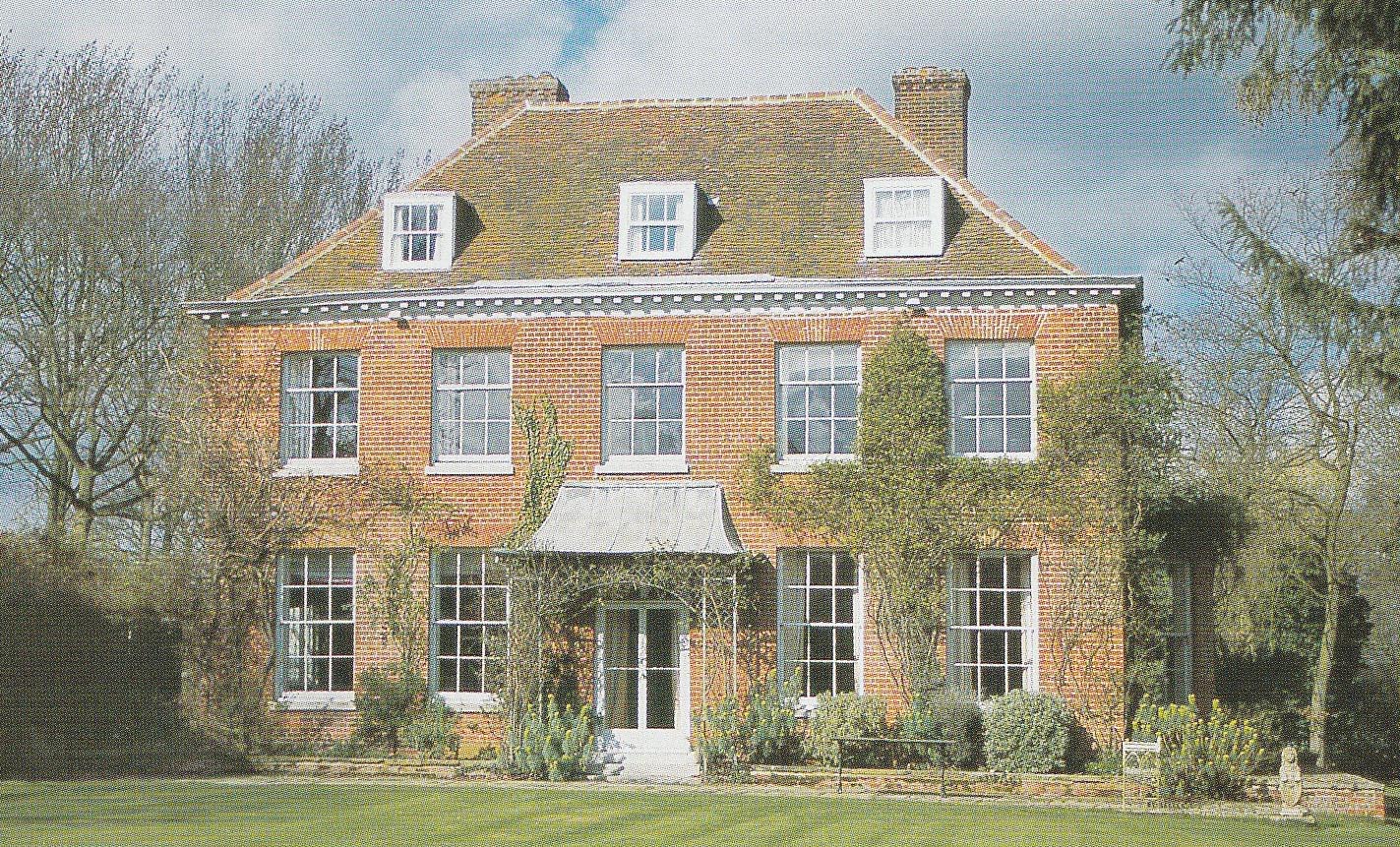

2006
1708: The New Courts Repertorium mentions the terrier of 1600 which lists "a parsonage house, most of it built by the then incumbent, Mr. Paul Kent, a tenement in the yard with two rooms for necessary uses. A cart house, a stable and also a fair orchard planted and fenced by him, a store house and a hen house adjoining and 52 acres of glebe land."
1533-1613: The glebe land in 1551-1661 lay between what was then Copford Water Hill down to the Great River. (the river Pant). Paul Kent was the Rector from 1533 to 1613 when he retired. He had five daughters and a son. Son John, married Maria Chishull in 1568 and he also had five daughters and a son. His daughter Frances was baptised in 1580 and her godparents were Paul Kent and Elizabeth and Jane Chishull. However, this Parsonage that Paul Kent built, where was it? Was it on the site of Manor Cottage, Chequers or the old Rectory? Judging from the outbuildings, Chequers or the old Rectory are most likely.
18th Century: The present building dates from around the end of the 18th century when Thomas Barnard was Rector.
Moilman's History of Essex quotes "The Parsonage which stands about three quarters of a mile from the Church on the road side leading from Sandford to Great Bardfield, is a handsome brick building entirely new built by the incumbent, Thomas Bernard.'”
Five of the family Bernard had been incumbents of the Church and lived in the Rectory. It was valued in 1831 at £472.
1906: The Rev. Edward Mears was Rector and between 1910 and 1940 he used the Old Rectory as a Theological Training College for young priests known as The Brotherhood of St Paul. Their course cost 25 guineas and over 300 priests were trained here. They lived with local families in both Little and Great Bardfield. At that time the Misses Creed lived at Chequers and one brother reports “That it was a measure of your success as a student, if you were invited to tea.”

Rev. Mears remined as Rector for 34 years until 1940, and he died in Stansted in 1947.
1968: The Old Rectory was sold into private hands when the benefices of Saint Mary in Great Bardfield and Saint Katharine in Little Bardfield were joined in 1968. According to the owner of that time, some very old foundations were uncovered in the course of repair work so it in not impossible that this is the site of Paul Kent's Parsonage. Apparently, The Brotherhood still maintains an interest in the Church to which they contributed so much.
Three Chimneys (Previously Three Cottages)
Grade 2 Listed July 1985. C13/C14 hall house. Possibly Tudor.

2006
Wainsford Farm
Grade 2 Listed February 1952. It lies 1,000 yards E.N.E. of the Church. Possibly Elizabethan, built around 1500 with later additions.
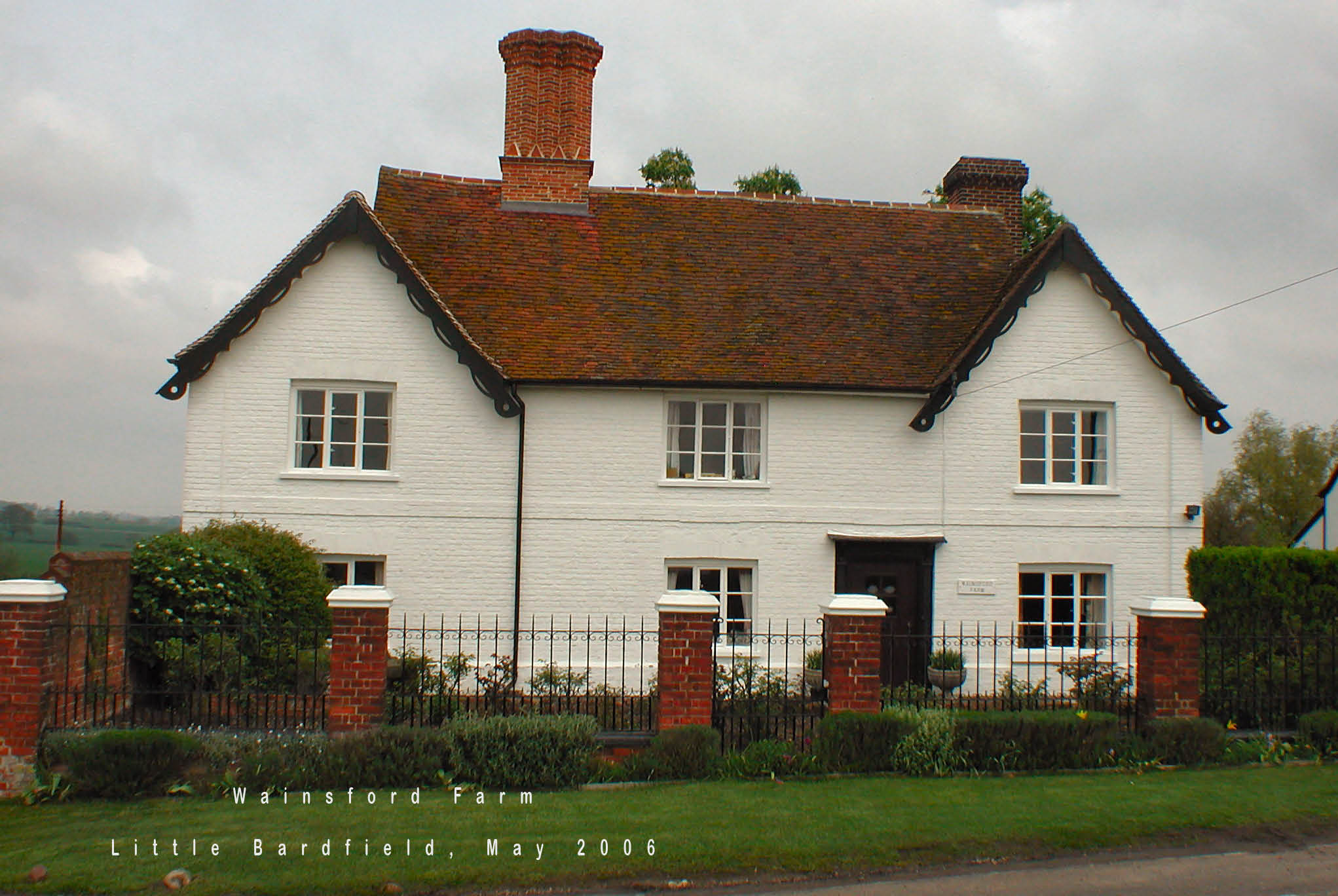
2006
The chimney stacks are typical 16th century. The house is frequently mentioned in the Parish History and is marked on a 1876 map as Wainford’s Farm. It was built on an L-shaped plan with the wings extending towards the east and north. The north wing being possibly of an earlier date than the east wing. In the 17th century a wing was added to the north side of the east wing and at some uncertain period the upper storey of the original north wing was removed. There are modern additions on the west side of the east wing and at the east end of the north wing and the south front has been refaced with modern brick. The central chimney stack of the 16th century has grouped diagonal shafts on a rectangular base with mounded cappings. In the original north wing, there are indications that the south half of the former upper storey projected. Inside the building the ground floor of the east wing has original moulded ceiling beams. In the north wing is an early 16th century doorway with a three centred head blocked by the later 16th century chimney stack.
| 1546-1552 | Thomas de Wanckford was the first owner of Wainsfords. Several Wangfords or Wanckfords are mentioned in the Parish Registers. Johanna married John Brown in 1552 and William married Elizabeth Littlechyld in 1553. Thomas was buried in 1551 and Germanus in 1546. The crest of the family "a lion rampant guardent gould holding between his paws a hurt". Thomas Wanckford made his will on the 6th September 1551 and in it he says he requires that his son William, "be half partner with his mother in all moveables within, and without, that is, cattle, corn now growing and all things pertaining to husbandry". He left to his second son, John "his little grey horse called Jack or another, to the value of four nobles. (A noble was worth six shillings and eightpence and was a gold piece.) Two beasts, a bullock and one seam of barley". He left to his daughter Johan "two beasts, a bullock, one seam of wheat and one seam of barley". His other daughter Elizabeth was left the same as her sister Johan. All the above legacies were to be delivered to his children on the day of their marriage. He left to "old Hawkisby, young Hawkisby, to Cass and to Mother Master seven shillings and eightpence to be divided between them." The residue of his goods and debts to his wife Johan who was made sole executor. It is interesting to think that Hawkspur Green was called Hawksby Green on old maps and the name must derive from John Hawkisby who is mentioned in this will. Also, John Hawkisby was cousin to Ann Bottolphe who was born a Chishull. Christopher Bottolphe then owned Wainsfords succeeded by William Chishull and after him Robert Stubbing who was brother in law to Geoffrey Wale. |
| 1698 | Giles Stock owned Wainsfords but curiously there is no mention of him in any of the Parish Registers. |
| 1730 | "The poor parishioners have a yearly rent charge of thirty shillings a year left by Geoffrey Wale to come out of Wainsfords Farm". |
| 1733 | Ezekial Smith owned it. |
| 1807 | Humphrey Smith owned it and also Pauls Farm and Chequers. |
| 1838 | Wainsfords had 120 acres which made it quite a large farm. |
| 1848 | When William Spicer lived there as the tenant farmer to Humphrey Smith, he called it "Spicers" |
| 1900 | G A E Sadler lived there until 1900 |
| 1900 | Mr. Creed bought it and it was tenanted by Harold Raven. |
| 1908 | N. Reynolds |
| 1915-1948 | Oliver Reynolds |
| 1948 | Mr Foster |
| 1952 | It was bought by Mr. Gardiner who sold it to Miss. Grace Tyler. |
| 2017 | Mr & Mrs John Judson, who had lived there for many years, sold it and moved to Clare |
Other Houses of Interest
Fallow End

2006
Guivers

2006
Spread Eagle (Public House)


1920

2006
Squirrels

2006
Yew Tree Cottage

1919

2006

